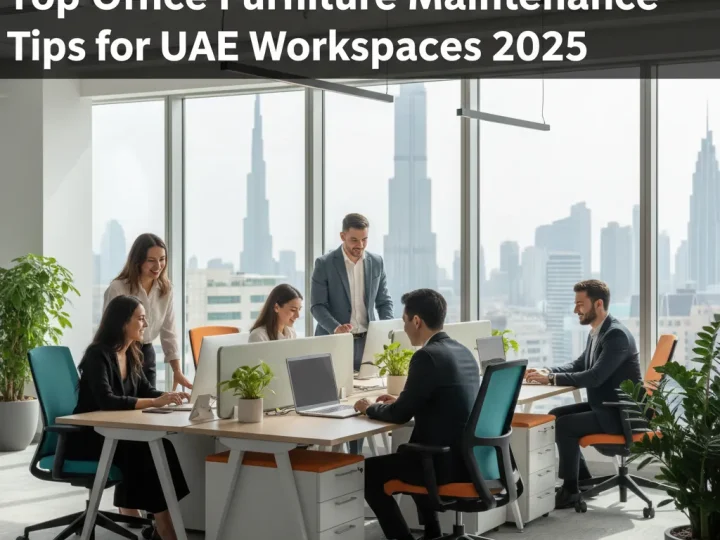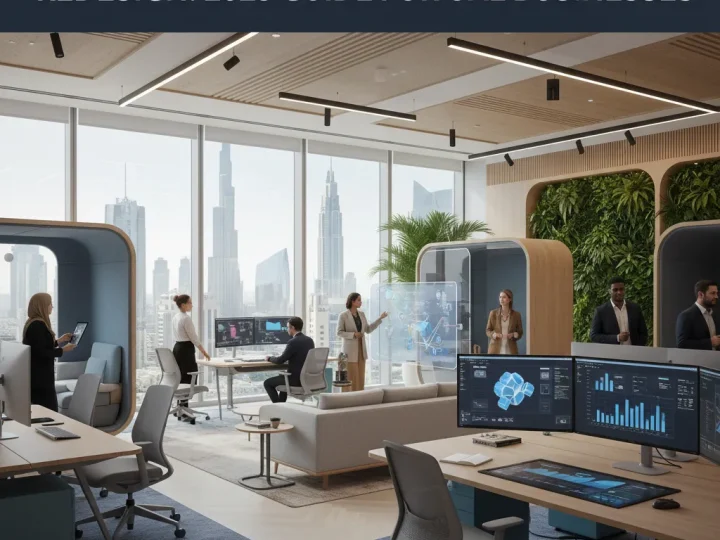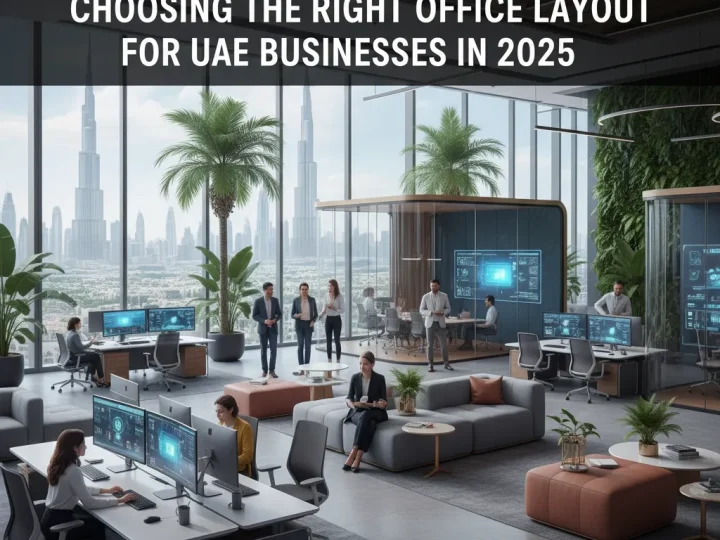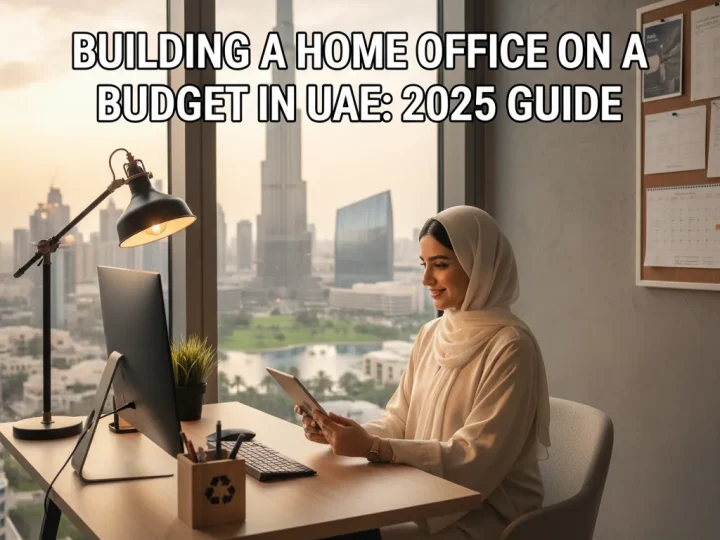

The office furniture revolution is underway, and it’s transforming employee productivity. Studies reveal that ergonomic furniture can reduce musculoskeletal disorders by up to 59%, making a significant impact on workplace efficiency. But here’s the kicker: it’s not just about comfort and pain relief. The true game changer lies in how aesthetic design, flexibility, and technology integration can supercharge creativity and collaboration. As businesses gear up for 2025, understanding these elements may be the key to unlocking your team’s full potential.
Table of Contents
- Impact Of Office Furniture Choices
- Ergonomics And Employee Wellbeing
- Designing Spaces For Team Collaboration
- 2025 Trends In Office Furniture
Quick Summary
| Takeaway | Explanation |
|---|---|
| Ergonomic furniture enhances productivity | Investing in ergonomic designs can reduce musculoskeletal disorders by up to 59%, translating to fewer sick days and increased focus. |
| Flexibility is key in modern office design | Modular furniture enables quick reconfiguration, supporting diverse work styles and maximizing limited office space, which is particularly valuable in growing UAE markets. |
| Aesthetic choices influence employee perception | Thoughtfully selected furniture can elevate brand identity and create an environment that fosters pride and motivation among employees. |
| Integration of technology in furniture is essential | Smart furniture features, such as wireless charging and environmental sensors, are becoming standard, facilitating seamless interaction between employees and their workspace. |
| Sustainability must be a priority | By 2025, businesses should prioritize furniture designed with circular principles and sustainable materials, as this aligns with corporate environmental strategies. |
Impact of Office Furniture Choices
Physical Comfort and Health Outcomes

The furniture choices you make for your office directly impact your employees’ physical well-being. Poorly designed chairs can lead to back pain, while inadequate desk heights might cause wrist strain. These physical discomforts aren’t just minor inconveniences—they create a continuous distraction that prevents workers from focusing on their tasks.
Ergonomic furniture addresses these issues by supporting proper posture and reducing physical strain. When employees aren’t constantly shifting to find comfort or stretching to relieve pain, they can maintain focus for longer periods. Studies show that ergonomic improvements can reduce musculoskeletal disorders by up to 59%, directly translating to fewer sick days and higher productivity.
Beyond physical comfort, height-adjustable desks allow employees to alternate between sitting and standing throughout the day. This simple change increases blood flow, reduces fatigue, and has been shown to boost energy levels. Many UAE businesses are now recognizing that investing in quality ergonomic furniture isn’t just about employee comfort—it’s a strategic decision that affects their bottom line.
Psychological Impact on Workplace Performance
Office furniture choices send powerful messages about company values. When employees walk into an office outfitted with thoughtfully selected, quality furniture, they perceive that their employer values their comfort and well-being. This perception fosters a sense of appreciation that directly influences motivation levels.
The psychological impact extends to how employees interact with their environment. Comfortable, well-designed furniture creates a sense of ownership and pride in the workspace. When employees feel at home in their environment, they’re more likely to invest emotionally in their work.
Furniture arrangements also affect social dynamics. Collaborative spaces with comfortable seating encourage spontaneous discussions and idea sharing. Meanwhile, acoustically designed furniture pieces can create quiet zones where focused work happens without interruption. These environmental factors shape how employees interact and collaborate, ultimately influencing creativity and problem-solving capacity.
Workplace Flexibility and Adaptation
Today’s workplaces must accommodate diverse work styles and tasks. Modern office furniture solutions provide this flexibility through modular designs that can be reconfigured as needs change. This adaptability is particularly valuable for growing businesses in Dubai and across the UAE, where organizational needs evolve rapidly.
Flexible furniture arrangements allow spaces to transform from individual work areas to collaborative meeting spaces within minutes. This capability maximizes the utility of limited office space—a significant consideration in premium commercial districts in Dubai and Abu Dhabi.
Adaptable furniture options also accommodate different employee preferences. Some team members may prefer traditional desk setups, while others work better in more relaxed settings. By providing various furniture configurations, employers can support these individual work styles while maintaining a cohesive office environment.
Aesthetic Impact on Creativity and Brand Identity
The visual impact of office furniture extends beyond mere appearance—it influences how people think and feel in a space. Color psychology plays a significant role here: blues can promote calm focus, while yellows might stimulate creativity and energy. Through thoughtful furniture selection, you can create environmental cues that support different types of cognitive work.
Furniture choices also reflect and reinforce company culture and brand identity. A tech startup might select modern, unconventional pieces that communicate innovation, while a financial institution might choose classic designs that convey stability and tradition. For UAE businesses looking to make a statement to clients and employees alike, furniture becomes an extension of brand communication.
The right office furniture doesn’t just affect current employees—it impacts recruitment efforts as well. When prospective talent visits your office, they quickly form impressions about your company culture based on the physical environment. Forward-thinking furniture choices signal a progressive approach that can help attract top talent in competitive UAE markets.
By understanding these diverse impacts of office furniture on productivity, businesses can make more strategic decisions about their workplace environments, creating spaces that truly support their most valuable asset: their people.
Ergonomics and Employee Well-being
The Science Behind Ergonomic Design
Ergonomics isn’t just a trendy workplace concept—it’s a science focused on designing equipment and spaces that maximize productivity while reducing discomfort and risk of injury. For UAE businesses, understanding this science can transform workplace performance and employee satisfaction.
At its core, ergonomics studies how the human body interacts with its environment. Each person has unique physical dimensions and needs, which is why one-size-fits-all furniture often falls short. Proper ergonomic design accounts for the natural curves of the spine, the neutral positioning of wrists and arms, and the ideal angles for viewing screens.
The application of ergonomics in office furniture design isn’t merely about comfort—it’s about aligning the work environment with human physiology. When your office chairs support the natural S-curve of employees’ spines, when desk heights accommodate proper arm positioning, and when monitors sit at eye level, you’re creating conditions where bodies can work efficiently without strain.
For Dubai entrepreneurs and facility managers in the UAE, implementing proper ergonomics means recognizing that the human body wasn’t designed for hours of static sitting. Movement is essential, making adjustable furniture that allows position changes throughout the day a worthy investment for forward-thinking companies.
Preventing Workplace Injuries and Discomfort
Office work may not seem physically demanding, but prolonged sitting and repetitive movements create significant physical stress. Common office-related health issues include lower back pain, neck strain, carpal tunnel syndrome, and eye fatigue—all of which directly impact productivity and attendance.
Strategic furniture choices can prevent these issues before they develop. Chairs with adjustable lumbar support help maintain proper spine alignment, reducing back pain risk. Properly positioned keyboards and ergonomic mice minimize wrist strain. Monitor arms that allow for eye-level viewing reduce neck strain and eye fatigue.
Beyond the physical equipment, training employees on proper ergonomic practices multiplies the benefits of your furniture investments. Simple adjustments in sitting posture, regular movement breaks, and correct workstation setup can dramatically reduce discomfort and injury risk. For UAE businesses, offering ergonomics training when introducing new furniture ensures you maximize the return on your investment.
The cost of ignoring ergonomics extends beyond immediate discomfort. Poor ergonomics leads to increased sick days, medical claims, and potential long-term disability leaves—all representing significant business costs that far exceed the investment in quality furniture.
Mental Well-being and Cognitive Performance
The benefits of ergonomic furniture extend beyond physical health to mental well-being. Physical discomfort is a powerful distraction that drains mental energy and focus. When employees aren’t constantly adjusting their position to alleviate pain, they can direct more cognitive resources toward their work.
Quality ergonomic furniture also reduces mental fatigue by eliminating environmental stressors. Uncomfortable seating, cramped workspaces, and poor lighting create subtle but persistent stress that accumulates throughout the workday. By removing these stressors, properly designed workspaces help maintain mental clarity and focus.
For UAE businesses competing for top talent, demonstrating a commitment to employee well-being through ergonomic workspaces signals a progressive company culture. This commitment becomes increasingly important as awareness of workplace health continues to grow among skilled professionals in Dubai and throughout the Emirates.
Customization for Diverse Workforces
Ergonomic solutions are most effective when they accommodate individual differences. Your workforce likely includes people of various heights, weights, and physical needs—making adjustability a critical feature in office furniture.
For startups and growing businesses in the UAE, investing in adjustable furniture provides flexibility as your team evolves. Highly adjustable chairs, height-adjustable desks, and movable monitor arms can accommodate new employees without requiring replacement furniture.
Consider also the diverse work styles within your organization. Some tasks require intense focus and minimal movement, while others benefit from collaboration and frequent position changes. Ergonomic furniture that supports these different modalities—from focused work to collaborative sessions—helps employees perform at their best across various tasks.
The most successful UAE workplaces recognize that ergonomics isn’t a one-time consideration but an ongoing commitment. Regular assessment of furniture effectiveness, employee feedback collection, and willingness to make adjustments ensure your ergonomic investments continue delivering value as your business evolves and grows.
By prioritizing ergonomics in your office furniture decisions, you’re not just purchasing physical assets—you’re investing in the well-being and productivity of your greatest resources: your people.
Designing Spaces for Team Collaboration
Balance Between Open and Private Spaces
Effective collaboration doesn’t happen in a one-size-fits-all environment. The most productive workplaces in the UAE are those that strike a thoughtful balance between open collaboration areas and private spaces for focused work. This balance recognizes that team creativity flourishes when people can easily interact, but also acknowledges that privacy remains essential for certain tasks and conversations.
Open collaborative spaces work best when they’re intentionally designed with the right furniture elements. Consider modular seating arrangements that can be easily reconfigured as team sizes and project needs change. Rounded tables encourage equal participation by allowing all participants to see one another, while standing-height tables can energize quick brainstorming sessions and prevent meetings from dragging on.
Private spaces complement these open areas by providing acoustic refuge when needed. Phone booths, small meeting pods, and semi-enclosed work lounges offer privacy without complete isolation. For UAE businesses operating in competitive industries where intellectual property protection matters, these private spaces become essential for sensitive discussions while still maintaining an overall collaborative atmosphere.
The key to success lies not in choosing between open or private but in creating a workspace ecosystem where both options are readily available. This approach allows employees to select the environment that best suits their current task, enhancing both collaboration quality and individual productivity.
Furniture That Facilitates Interaction
Collaboration-focused furniture does more than provide a place to sit—it actively shapes how people interact and share ideas. In Dubai’s innovative business landscape, furniture choices can make the difference between performative collaboration and genuine creative exchange.
Consider the humble meeting table. Rectangular tables with clear hierarchical positions (the head of the table) subtly reinforce power dynamics, while round or oval tables democratize participation. Similarly, lounge-style seating areas with comfortable armchairs arranged in small clusters encourage informal exchanges that often lead to unexpected insights.
Whiteboard surfaces integrated into tables, movable writing boards, and mobile display screens allow ideas to be captured and built upon in real-time. These tactical tools are particularly valuable for UAE startups and creative agencies where visualizing concepts is a fundamental part of the creative process.
Modular furniture systems provide the adaptability that dynamic businesses need. Pieces that can be reconfigured quickly allow spaces to transform from presentation setups to brainstorming circles to project work areas within minutes. For growing UAE businesses with limited square footage, this adaptability maximizes the utility of available space.
Technology Integration in Collaborative Settings
In today’s workplace, physical and digital collaboration must seamlessly integrate. Smart furniture design accounts for this reality by incorporating technology enablement as a core feature rather than an afterthought.
Power access becomes fundamental—collaborative furniture should feature easily accessible outlets and USB ports to keep devices charged during extended sessions. Cable management solutions prevent the visual and physical clutter that can disrupt creative flow.
For UAE businesses with international connections, collaborative spaces must support video conferencing with appropriate lighting, acoustics, and display positioning. Furniture that can easily transition between in-person collaboration and virtual meetings provides versatility for hybrid work patterns that have become increasingly common.
Consider also how furniture can accommodate different technology-sharing styles. Some teams prefer individual devices, requiring surfaces that comfortably fit multiple laptops. Others work best with shared displays, necessitating seating arrangements with clear sightlines to screens. Understanding your team’s working style should inform these furniture decisions.
Creating Zones for Different Collaboration Styles
Collaboration isn’t a monolithic activity. It encompasses everything from spontaneous two-person conversations to structured workshops with dozens of participants. Effective workplace design acknowledges these variations by creating distinct zones for different collaboration styles.
Informal collision spaces—equipped with comfortable standing-height tables or casual seating—encourage the spontaneous exchanges that often spark innovation. Placing these areas near high-traffic locations like coffee bars or printer stations increases the likelihood of valuable chance encounters.
For scheduled collaboration, enclosed meeting rooms with appropriate acoustic properties ensure discussions remain private while providing the tools needed for structured meetings. Varying the size and setup of these rooms accommodates different team sizes and meeting purposes.
Project spaces designed for ongoing collaboration provide teams with dedicated areas where materials can remain in place between sessions. This continuity is particularly valuable for UAE businesses engaged in complex projects where maintaining context between meetings accelerates progress.
For interior designers in Dubai and facility managers across the UAE, understanding the specific collaboration needs of different business functions is essential. A marketing team’s collaborative requirements differ significantly from those of a software development team or a financial department. The most successful workplace designs acknowledge these variations with tailored collaborative environments.
By thoughtfully designing collaborative spaces with appropriate furniture selections, UAE businesses can create environments where teams naturally share ideas, solve problems collectively, and develop the innovative thinking that drives business success in competitive markets.
2025 Trends in Office Furniture
Biophilic Design Integration
The UAE office landscape is increasingly embracing biophilic design—a concept that incorporates natural elements into built environments. This trend reflects growing research showing that connection to nature improves cognitive function, reduces stress, and enhances creativity. By 2025, we’ll see this philosophy deeply integrated into office furniture design rather than treated as separate decorative elements.

Furniture pieces are evolving to incorporate living plants as structural components. Desks with built-in planters, room dividers with vertical gardens, and seating with integrated greenery will become mainstream options for UAE workplaces. These pieces serve multiple purposes: bringing nature indoors, improving air quality, and creating visual interest that stimulates creativity.
Natural materials will dominate furniture construction, with sustainably sourced woods, bamboo, rattan, and stone replacing synthetic materials where possible. The texture and variability of these materials create sensory-rich environments that stand in pleasant contrast to the digital interfaces employees engage with throughout their workday.
Color palettes are shifting toward nature-inspired tones—forest greens, oceanic blues, and earthy neutrals—which research suggests can reduce eye strain and promote calm focus. For Dubai businesses looking to create distinctive yet psychologically supportive environments, these biophilic elements offer a powerful combination of aesthetic appeal and functional benefits.
Adaptability for Hybrid Work Models
The pandemic-accelerated shift toward hybrid work is reshaping office furniture requirements. By 2025, offices in the UAE and Dubai will fully embrace furniture designed specifically for spaces that serve both in-person and remote collaboration.
Modular furniture systems for Dubai businesses will reach new levels of flexibility, with components that can be quickly reconfigured as occupancy levels fluctuate throughout the week. Desks and workstations designed for hoteling (unassigned, reservable use) will feature integrated sanitization features, personal storage solutions, and quick-adjust ergonomic elements that remember individual preferences.
Meeting spaces will continue evolving to better support hybrid interactions. Furniture designed for video conferencing will incorporate acoustic properties that minimize background noise, integrated camera positions that capture all participants equally, and lighting elements that ensure remote participants can clearly see everyone in the room.
For UAE entrepreneurs establishing new offices, investing in these hybrid-ready furniture solutions will future-proof workspaces against continuing evolution in work patterns. The ability to easily adapt space as team dynamics and collaboration needs change will become a critical competitive advantage.
Smart Furniture Becomes Standard
By 2025, the distinction between furniture and technology will blur significantly as smart features become standard rather than premium add-ons. For UAE businesses at the forefront of innovation, these integrated solutions will transform how employees interact with their physical environment.
Desks will routinely include wireless charging surfaces, environmental sensors that monitor air quality and temperature, and interfaces that connect to workplace apps for booking and personalization. These smart surfaces will adjust height based on recognized user preferences without manual controls.
Seating will incorporate sensors that monitor posture and prompt subtle adjustments when employees maintain unhealthy positions for too long. These intelligent chairs will track usage patterns and suggest movement breaks calibrated to individual work habits.
Storage solutions will evolve from passive containers to active systems that track contents, secure sensitive materials through biometric access, and integrate with digital inventory systems. For UAE facilities managers, these features simplify asset tracking while enhancing security in dynamic office environments.
Sustainability as a Core Design Principle
Environmental consciousness is moving from a marketing feature to a fundamental design requirement for office furniture. By 2025, UAE businesses will expect comprehensive sustainability credentials for all workplace furnishings.
Circular design principles will dominate, with furniture designed from the outset for disassembly, repair, and eventual recycling. Manufacturers will offer take-back programs that ensure responsible end-of-life processing, and many will transition to service models where furniture is leased rather than purchased outright.
Material innovation will accelerate, with bio-based alternatives replacing petroleum-derived components. Recycled ocean plastics, agricultural waste products, and carbon-negative materials will become mainstream options rather than specialty alternatives. These materials will meet or exceed the performance specifications of traditional options while significantly reducing environmental impact.
For UAE businesses committed to meeting ambitious sustainability goals, furniture selection will become an increasingly important component of corporate environmental strategies. The carbon footprint of workplace furnishings will be routinely calculated as part of overall facilities management.
Neurodiversity-Conscious Design
As workplace inclusivity extends beyond physical accessibility to cognitive diversity, furniture design is responding with solutions that accommodate different neurological profiles. This trend recognizes that employees process sensory information differently and need varied environmental supports to perform at their best.
Acoustic furniture that creates sensory retreats will become more sophisticated, offering spaces where employees sensitive to noise or visual stimulation can find respite without leaving the office floor. These pieces will incorporate sound-absorbing materials, adjustable lighting, and visual barriers that can be deployed as needed.
Sensory-friendly seating options will expand, with designs that accommodate stimming behaviors, provide proprioceptive feedback, or minimize uncomfortable sensations for those with tactile sensitivities. These options will be integrated aesthetically into overall office design rather than appearing as specialized accommodations.
For UAE businesses cultivating diverse talent pools, these neurodiversity-conscious furniture choices signal a commitment to inclusive workplaces where all employees can access the environmental conditions they need to thrive.
Frequently Asked Questions
What impact does ergonomic furniture have on employee productivity?
Investing in ergonomic furniture can reduce musculoskeletal disorders by up to 59%, which translates to fewer sick days and enhanced focus, ultimately boosting employee productivity.
How can office design affect employee well-being?
Thoughtfully designed office spaces with ergonomic furniture promote physical comfort and mental clarity. This leads to increased engagement and motivation among employees.
What are the key trends in office furniture for 2025?
Key trends include biophilic design integration, smart furniture features, adaptability for hybrid work models, and a strong focus on sustainability in materials and construction.
How can office furniture choices reflect a company’s brand identity?
The choice of office furniture communicates company values and culture, impacting employee perception and potentially attracting top talent. Modern, stylish designs can enhance brand identity and promote a positive work environment.
Transform Your Workspace to Unlock Productivity
Are you ready to harness the full potential of your team in 2025? As highlighted in our latest article, “Boosting Office Furniture and Employee Productivity in 2025,” the integration of ergonomic, flexible, and aesthetically pleasing office furniture plays a pivotal role in reducing physical discomfort and enhancing collaborative efforts among employees. Imagine a workspace where creativity flows, motivation skyrockets, and your brand identity resonates through every piece of furniture.

At SAGTCO, we understand the pain points that come with outdated office furniture and uninspired workspaces. With our extensive range of modern and customizable office solutions, we empower businesses throughout the UAE to design environments that support productivity and employee well-being. Our easy-to-navigate website allows you to explore tailored options that cater to every aspect of your workspace needs—from ergonomic chairs and adjustable desks to collaborative settings that encourage creativity.
Don’t wait! Elevate your office environment NOW by visiting SAGTCO.com. Discover how our expert consultation for free space planning can turn your vision into reality and make your workplace a haven of productivity and inspiration. Act today to ensure your office is geared up for the future!




